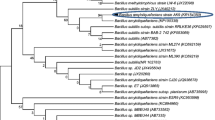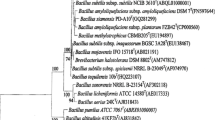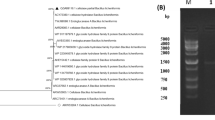Abstract
In the current study, an extracellular cellulase belonging to symbiotic Bacillus subtilis Bc1 of the leopard moth is purified and characterized. The molecular mass of enzyme was 47.8 kDa using SDS-PAGE. The purified enzyme had optimum activity in temperature and pH around 60 °C and 8, respectively. The purified cellulase was introduced as a stable enzyme in a wide variety of temperature (20–80 °C) and pH (4–10) and remained active to more than 74% at 80 °C for 1 h. Moreover, the cellulase extremely was stabled in the presence of metal ions and organic solvents and its activity was increased by acetone (20% v/v), CaCl2 and CoCl2 and inhibited by MnCl2 and NiCl2. The values of enzyme's Km and Vmax were found to be 1.243 mg/mL and 271.3 µg/mL/min, respectively. The purified cellulase hydrolyzed cellulose, avicel and carboxymethyl cellulose (CMC) and the final product of CMC hydrolysis was cellobiose using thin-layer chromatography analysis. Consequently, owing to exo/endoglucanase activity and organic solvent, temperature and pH stability of the purified cellulase belong to B. subtilis BC1, it can be properly employed for various industrial purposes.




Similar content being viewed by others
Abbreviations
- CMC:
-
Carboxymethyl cellulose
- CTAB:
-
Cetyl trimethylammonium bromide
- DNS:
-
Dinitrosalicylic acid
- NCBI:
-
National center for biotechnology information
- PCR:
-
Polymerase chain reaction
- SDS-PAGE:
-
Sodium dodecyl sulfate–polyacrylamide gel
- TLC:
-
Thin-layer chromatography
References
Ohkuma M (2003) Termite symbiotic systems: efficient bio-recycling of lignocellulose. Appl Microbiol Biotechnol 61(1):1–9
Sindhu R, Binod P, Pandey A (2016) Biological pretreatment of lignocellulosic biomass–An overview. Bioresour Technol 199:76–82
Zhou H, Guo W, Xu B, Teng Z, Tao D, Lou Y, Gao Y (2017) Screening and identification of lignin-degrading bacteria in termite gut and the construction of LiP-expressing recombinant Lactococcus lactis. Microb Pathog 112:63–69
Cortes-Tolalpa L, Salles JF, van Elsas JD (2017) Bacterial synergism in lignocellulose biomass degradation—Complementary roles of degraders as influenced by complexity of the carbon source. Front Microbiol 8:1628
Knowles J, Lehtovaara P, Teeri T (1987) Cellulase families and their genes. Trends Biotechnol 5(9):255–261
Singh R, Kumar M, Mittal A, Mehta PK (2016) Microbial cellulases in industrial applications. Ann appl Biosci 3(4):23–29
Trivedi N, Reddy C, Lali A (2016) Marine microbes as a potential source of cellulolytic enzymes. Advances in food and nutrition research. Elsevier, Amsterdam, pp 27–41
Engel P, Moran NA (2013) The gut microbiota of insects–diversity in structure and function. Fems Microbiol Rev 37(5):699–735
Tartar A, Wheeler MM, Zhou X, Coy MR, Boucias DG, Scharf ME (2009) Parallel metatranscriptome analyses of host and symbiont gene expression in the gut of the termite Reticulitermes flavipes. Biotechnol Biofuels 2(1):25
Lo N, Tokuda G, Watanabe H (2010) Evolution and function of endogenous termite cellulases. Biology of termites: a modern synthesis. Springer, New York, pp 51–67
Prasad RK, Chatterjee S, Sharma S, Mazumder PB, Vairale MG, Raju PS (2018) Insect gut bacteria and their potential application in degradation of lignocellulosic biomass: a review. Bioremediation: applications for environmental protection and management. Springer, New York, pp 277–299
Salari E, Karimi J, Sadeghi-Nameghi H, Hosseini M (2015) Efficacy of two entomopathogenic nematodes Heterorhabditis bacteriophora and Steinernema carpocapsae for control of the leopard moth borer Zeuzera pyrina (Lepidoptera: Cossidae) larvae under laboratory conditions. Biocontrol Sci Technol 25(3):260–275
Hatefi A, Makhdoumi A, Asoodeh A, Mirshamsi O (2017) Characterization of a bi-functional cellulase produced by a gut bacterial resident of Rosaceae branch borer beetle, Osphranteria coerulescens (Coleoptera: Cerambycidae). Int J Biol Macromol 103:158–164
Wood PJ, Erfle JD, Teather RM (1988) Use of complex formation between Congo Red and polysaccharides in detection and assay of polysaccharide hydrolases. Methods Enzymol 160:59–74
Murray R (1994) Determinative and cytological light microscopy. Methods for general and molecular bacteriology. American Society for Microbiology, Washington, DC, pp 7–20
Wood WA, Krieg NR (1989) Methods for general and molecular bacteriology. ASM Press, Washington DC
Garrity GM (2012) Bergey's manual of systematic bacteriology volume one: the archaea and the deeply branching and phototrophic bacteria. Springer, New York
Miller GL (1959) Use of dinitrosalicylic acid reagent for determination of reducing sugar. Anal Chem 31(3):426–428
Lane DJ, Pace B, Olsen GJ, Stahl DA, Sogin ML, Pace NR (1985) Rapid determination of 16S ribosomal RNA sequences for phylogenetic analyses. Proc Natl Acad Sci 82(20):6955–6959
Bradford MM (1976) A rapid and sensitive method for the quantitation of microgram quantities of protein utilizing the principle of protein-dye binding. Anal Biochem 72(1–2):248–254
Zhang Z, Xie J, Zhang F, Linhardt RJ (2007) Thin layer chromatography for the analysis of glycosaminoglycan oligosaccharides. Anal Biochem 371(1):118
Bourtzis K, Miller TA (2003) Insect symbiosis. CRC Press, Boca Raton
Yun J-H, Roh SW, Whon TW, Jung M-J, Kim M-S, Park D-S, Yoon C, Nam Y-D, Kim Y-J, Choi J-H (2014) Insect gut bacterial diversity determined by environmental habitat, diet, developmental stage, and phylogeny of host. Appl Environ Microbiol 80(17):5254–5264
Manfredi AP, Perotti NI, Martínez MA (2015) Cellulose degrading bacteria isolated from industrial samples and the gut of native insects from Northwest of Argentina. J Basic Microbiol 55(12):1384–1393
Bhuyan PM, Sandilya SP, Nath PK, Gandotra S, Subramanian S, Kardong D, Gogoi DK (2018) Optimization and characterization of extracellular cellulase produced by Bacillus pumilus MGB05 isolated from midgut of muga silkworm (Antheraea assamensis Helfer). J Asia-Pac Entomol 21(4):1171–1181
Prem Anand AA, Vennison SJ, Sankar SG, Gilwax Prabhu DI, Vasan PT, Raghuraman T, Jerome Geoffrey C, Vendan SE (2010) Isolation and characterization of bacteria from the gut of Bombyx mori that degrade cellulose, xylan, pectin and starch and their impact on digestion. J Insect Sci 10(1):107
Wei KSC, Teoh TC, Koshy P, Salmah I, Zainudin A (2015) Cloning, expression and characterization of the endoglucanase gene from Bacillus subtilis UMC7 isolated from the gut of the indigenous termite Macrotermes malaccensis in Escherichia coli. Eletron J Biotechnol 18(2):103–109
Ratnadewi AAI, Santoso AB, Sulistyaningsih E, Handayani W (2016) Application of cassava peel and waste as raw materials for xylooligosaccharide production using endoxylanase from Bacillus subtilis of soil termite abdomen. Procedia Chem 18:31–38. https://doi.org/10.1016/j.proche.2016.01.007
Siu-Rodas Y, de los Angeles Calixto-Romo M, Guillén-Navarro K, Sánchez JE, Zamora-Briseño JA, Amaya-Delgado L (2018) Bacillus subtilis with endocellulase and exocellulase activities isolated in the thermophilic phase from composting with coffee residues. Rev Argent Microbiol 50(3):234–243
Yin L-J, Lin H-H, Xiao Z-R (2010) Purification and characterization of a cellulase from Bacillus subtilis YJ1. J Mar Sci Techol 18(3):466–471
Nimchua T, Thongaram T, Uengwetwanit T, Pongpattanakitshote S, Eurwilaichitr L (2012) Metagenomic analysis of novel lignocellulose-degrading enzymes from higher termite guts inhabiting microbes. J Microbiol Biotechnol 22(4):462–469
Fagbohunka B, Okonji R, Adenike AZ (2016) Purification and characterization of cellulase from termite Ametermes eveuncifer (Silverstri) soldiers. Int J Biol 9(1):1
Zi-Zhong T, Zhen-Fang W, Hui C, Xin L, Xue-yi H, Qi W (2013) Characterization of novel EGs reconstructed from Bacillus subtilis endoglucanase. Appl Biochem Biotechol 169(6):1764–1773
Annamalai N, Rajeswari MV, Elayaraja S, Balasubramanian T (2013) Thermostable, haloalkaline cellulase from Bacillus halodurans CAS 1 by conversion of lignocellulosic wastes. Carbohyd Polym 94(1):409–415
Zaks A, Klibanov AM (1988) Enzymatic catalysis in nonaqueous solvents. J Biol Chem 263(7):3194–3201
Zafar M, Ahmed S, Khan MIM, Jamil A (2014) Recombinant expression and characterization of a novel endoglucanase from Bacillus subtilis in Escherichia coli. Mol Biol Rep 41(5):3295–3302
Gaur R, Tiwari S (2015) Isolation, production, purification and characterization of an organic-solvent-thermostable alkalophilic cellulase from Bacillus vallismortis RG-07. BMC Biotechnol 15(1):19
Javaheri-Kermani M, Asoodeh A (2019) A novel beta-1, 4 glucanase produced by symbiotic Bacillus sp. CF96 isolated from termite (Anacanthotermes). Int J Biol Macromol 131:752–759
Li Y-H, Ding M, Wang J, Xu G-j, Zhao F (2006) A novel thermoacidophilic endoglucanase, Ba-EGA, from a new cellulose-degrading bacterium, Bacillus sp. AC-1. Appl Microbiol Biotechnol 70(4):430–436
Han SJ, Yoo YJ, Kang HS (1995) Characterization of a bifunctional cellulase and its structural gene The cel gene of Bacillus sp. D04 has exo-and endoglucanase activity. J Biol Chem 270(43):26012–26019
Bao L, Huang Q, Chang L, Zhou J, Lu H (2011) Screening and characterization of a cellulase with endocellulase and exocellulase activity from yak rumen metagenome. J Mol Catal B 73(1–4):104–110
Zhang F, Zhang X-M, Yin Y-R, Li W-J (2015) Cloning, expression and characterization of a novel GH5 exo/endoglucanase of Thermobifida halotolerans YIM 90462T by genome mining. J Biosci Bioeng 120(6):644–649
Wu B, Zheng S, Pedroso MM, Guddat LW, Chang S, He B, Schenk G (2018) Processivity and enzymatic mechanism of a multifunctional family 5 endoglucanase from Bacillus subtilis BS-5 with potential applications in the saccharification of cellulosic substrates. Biotechnol Biofuels 11(1):20
Author information
Authors and Affiliations
Corresponding author
Additional information
Publisher's Note
Springer Nature remains neutral with regard to jurisdictional claims in published maps and institutional affiliations.
Rights and permissions
About this article
Cite this article
Dehghanikhah, F., Shakarami, J. & Asoodeh, A. Purification and Biochemical Characterization of Alkalophilic Cellulase from the Symbiotic Bacillus subtilis BC1 of the Leopard Moth, Zeuzera pyrina (L.) (Lepidoptera: Cossidae). Curr Microbiol 77, 1254–1261 (2020). https://doi.org/10.1007/s00284-020-01938-z
Received:
Accepted:
Published:
Issue Date:
DOI: https://doi.org/10.1007/s00284-020-01938-z




